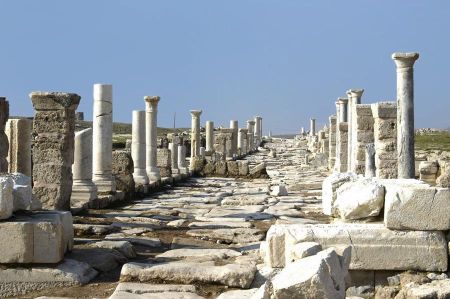Laodicea: mentioned in the New Testament
- Written by Portal Editor
Many of the ancient sites we visited in Turkey are closely related to the history of Christian development and are explicitly mentioned in the Bible in this respect, as it is the case with Laodicea.
Especially in the stories of the apostles settlement names like Tarsus are mentioned, which are not forgotten yet. As a further example, we would like to mention the settlement Laodicea, a nearly unknown place, despite its proximity to Hierapolis with its already well-known thermal baths and the world-famous calcareous terraces of Pamukkale. Here, just the thermal springs of Hierapolis were partly responsible for the economic emergence of Laodicea.
Laodicea - hot thermal water and dyeing fabrics
The city was literally run by spa guests and pilgrims, who considered the mineral-rich, warm spring water, which, no doubt, still has healing properties, to be sacred a lot. Thus, applications were offered that likened to today, a variety of people seeking help by the purpose of cures. Pilgrims came from far away for the sacred water, comparable to today's Lourdes in southern France. For Laodicea, the hot springs with the special composition of the thermal water were a blessing, using it they could prepare a very "special-effect" eye ointment. The economically second foothold, which we have already described in the article Laodicea, was the dyeing of fabrics. Due to the presence of red plant roots, which were diluted with water, it was possible to even dye black fabrics to purple. The purple was in his time the most popular colour among high-ranking personalities (and those who believed in themselves), which until then could only be made with purple snails from Syria, which was incredibly complicated and therefore too much expensive. So the famous purple sails of Cleopatra have been produced in Laodicea too. Both of these practices, eye cream as well as the purple dyeing of fabrics, were fundamentally rejected by the emerging Christians of his time.
Laodicea mentioned in the Colossians as a Christian community
From records it can be seen that Laodicea was the Metropolis of the province of Phrygia Pakatiane at the beginning of the 4th century. 363-364 the Council of Laodicea took place there. It was not until the big earthquake in 494 that Loadicea lost its importance. In the New Testament, Laodicea is mentioned in Colossians (2,1; 4,13.15.16) and also in the St. John's Apocalypse (1,11; 3,14) as the seat of a "Christian community".
Letter of the apostle Paulus to the community Laodicea
The Letter to Colossians (Col. 4:16) mentions some writings from Paul to the church in Laodicea which we did not have in all details. This message probably owes its origin to the so-called Laodicean letter, which encounters the biblical readers around the middle of the 6th century in some Latin manuscripts within the Pauline Epistles (Corpus Paulinum).
Laodicea - purified figures on sale to pilgrims
The letter to the Christian community in Laodicea was a special, indeed unusual letter, the seventh and last epistle of the Apocalypse of John (3: 14-22) to the seven churches. The municipality Laodicea is the only one who does not give the missive praise. Their own self-esteem of being rich and having no need stands in stark contrast to the judgment of Christ and the reference therein to essential shortcomings: being poor and miserable, poor and blind and naked (3:17). It therefore requires the Council (3:18) to buy "purified gold" (an allusion to the city's flourishing business of selling golden figures to pilgrims who sacrificed them in Hierapolis to recover from Pamukkale's waters), " white robes "(an allusion to the immense production of purple textiles) and "ointment" to the eyes (an allusion to the fact that the citizens sell eye ointment, but have not yet recognized the most important thing).
Eye ointment as an overcoming of spiritual blindness
This compilation (see Ezk. 16: 8-13) may be a recent reference to the economic importance of the city. In the biblical-symbolic language of the time, purified gold is to be read as an indication of past challenges, the white robes (Rev 3: 4, 7:14) as a symbol of fidelity, purity and forgiveness, but also for baptism and the associated reversal, the ophthalmic ointment as overcoming the spiritual blindness. In addition to these requests, Laodiceers are accused of being neither hot nor cold but lukewarm (inconsistent in their beliefs), also an allusion to the lukewarm thermal baths of Pamukkale, to which the city owes a large part of its wealth.
Please read as well:
Laodicea at Lycos near Pamukkale next to Denizli
Pamukkale - the cotton castle
